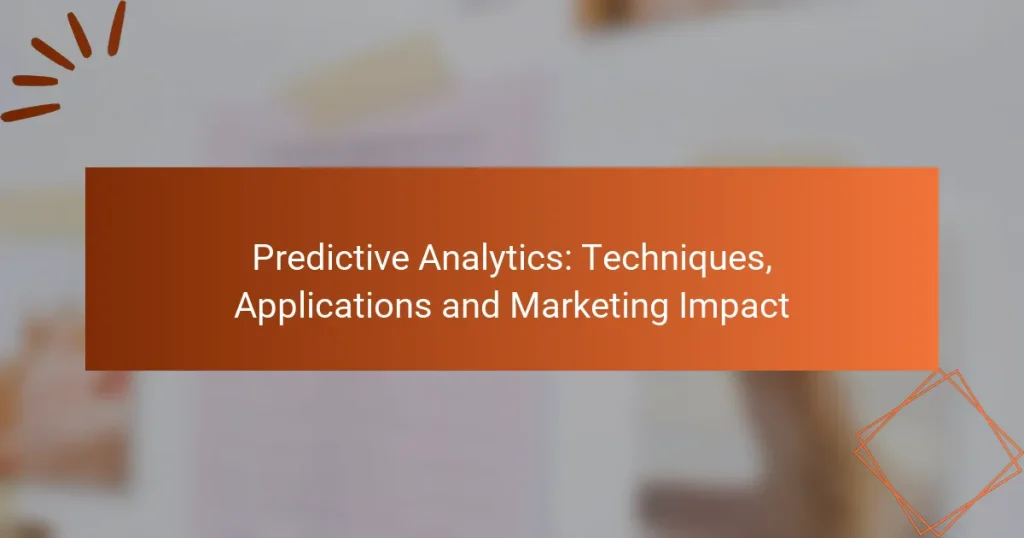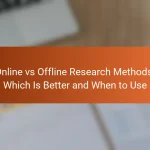Predictive analytics is a powerful tool that enhances marketing strategies by utilizing data to anticipate customer behavior and preferences. By employing techniques such as regression analysis, time series forecasting, and machine learning, businesses can tailor their marketing efforts, resulting in more effective campaigns and improved customer engagement.
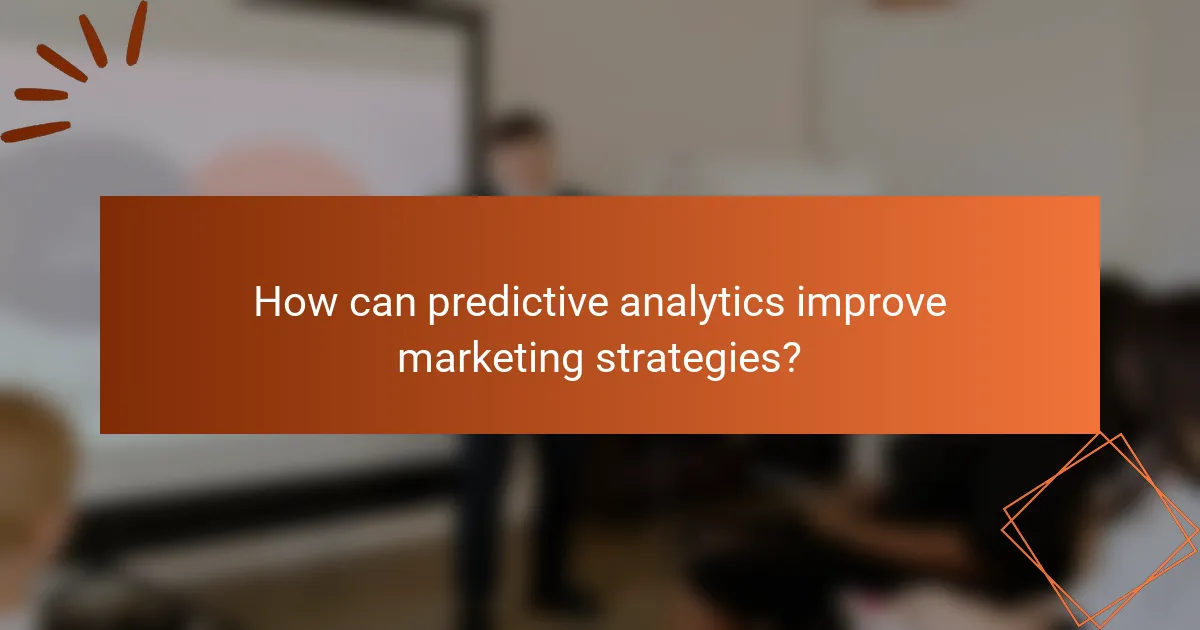
How can predictive analytics improve marketing strategies?
Predictive analytics enhances marketing strategies by leveraging data to forecast customer behavior and preferences. This approach allows marketers to tailor their efforts, leading to more effective campaigns and improved customer engagement.
Enhanced customer segmentation
Predictive analytics enables marketers to create more refined customer segments based on behavior, demographics, and purchasing patterns. By analyzing historical data, businesses can identify distinct groups and tailor their messaging to resonate with each segment.
For example, a retailer might use predictive models to segment customers into categories such as frequent buyers, occasional shoppers, and lapsed customers. This targeted approach can increase the relevance of marketing efforts and improve customer retention rates.
Optimized campaign targeting
With predictive analytics, marketers can optimize campaign targeting by identifying which customers are most likely to respond positively to specific offers. By analyzing past campaign performance and customer interactions, businesses can refine their targeting strategies.
For instance, a company may find that a particular demographic responds better to email promotions than social media ads. By focusing resources on the most effective channels, marketers can enhance engagement and drive conversions.
Increased ROI through data-driven decisions
Data-driven decisions powered by predictive analytics can significantly increase return on investment (ROI) for marketing campaigns. By understanding which strategies yield the best results, businesses can allocate their budgets more effectively.
Marketers should regularly assess the performance of their campaigns using predictive insights to adjust tactics in real-time. This proactive approach can lead to higher conversion rates and lower acquisition costs, ultimately maximizing ROI.
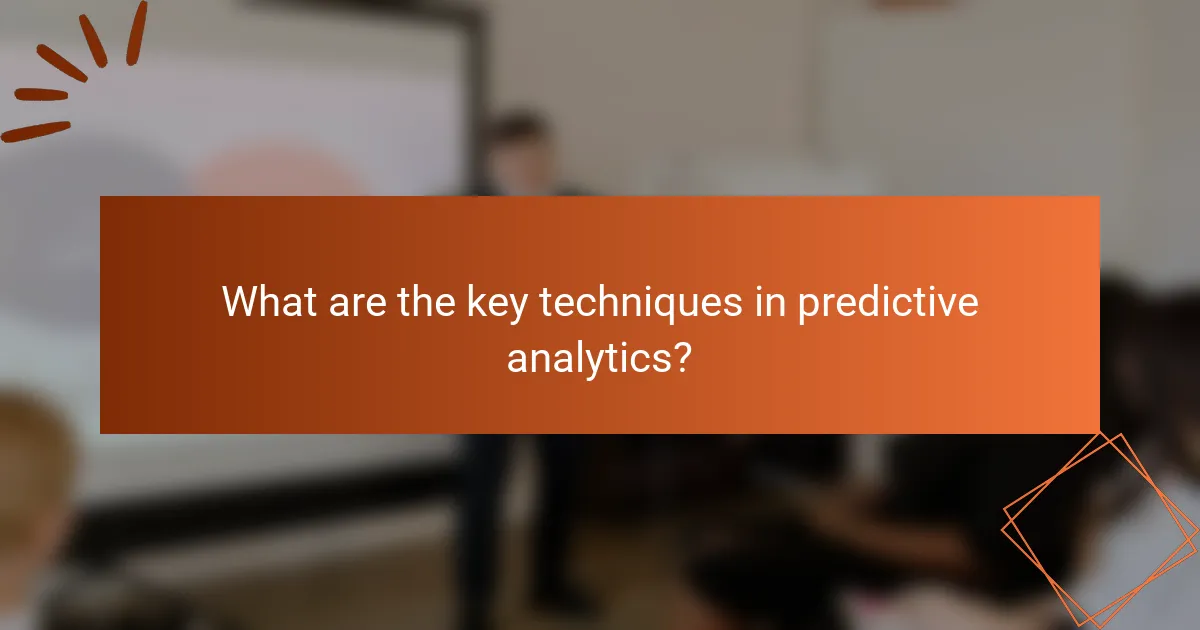
What are the key techniques in predictive analytics?
Key techniques in predictive analytics include regression analysis, time series forecasting, and machine learning algorithms. Each method offers unique strengths for analyzing data and making informed predictions based on historical trends and patterns.
Regression analysis
Regression analysis is a statistical method used to understand the relationship between variables. It helps predict the value of a dependent variable based on one or more independent variables, making it useful for identifying trends and forecasting outcomes.
Common types of regression include linear regression, which models a straight-line relationship, and logistic regression, used for binary outcomes. When applying regression analysis, ensure data quality and consider multicollinearity, which can skew results.
Time series forecasting
Time series forecasting involves analyzing data points collected or recorded at specific time intervals to predict future values. This technique is particularly effective for identifying seasonal patterns and trends over time.
Key methods include ARIMA (AutoRegressive Integrated Moving Average) and exponential smoothing. When using time series forecasting, it’s essential to account for external factors that may influence trends, such as economic changes or seasonal events.
Machine learning algorithms
Machine learning algorithms leverage large datasets to identify patterns and make predictions without explicit programming. These algorithms can adapt and improve over time, making them powerful tools for predictive analytics.
Common machine learning techniques include decision trees, random forests, and neural networks. When implementing machine learning, ensure you have sufficient data for training and validation, and be aware of potential overfitting, where models perform well on training data but poorly on new data.
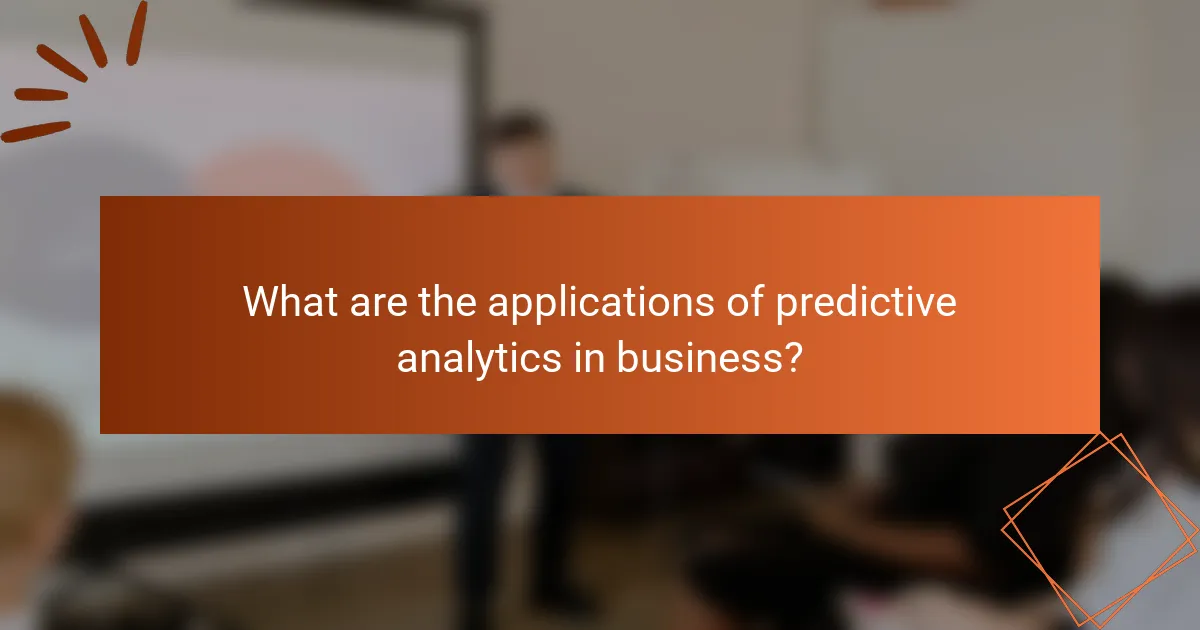
What are the applications of predictive analytics in business?
Predictive analytics in business is used to forecast future trends and behaviors based on historical data. Key applications include sales forecasting, customer behavior prediction, and risk assessment, which help organizations make informed decisions and optimize operations.
Sales forecasting
Sales forecasting utilizes predictive analytics to estimate future sales based on past performance and market trends. Businesses analyze historical sales data, seasonal patterns, and economic indicators to create models that project future sales figures.
For effective sales forecasting, companies should regularly update their models with new data and consider external factors such as market changes or competitor actions. A common approach is to use time series analysis or regression models to identify trends.
Customer behavior prediction
Customer behavior prediction involves analyzing data to anticipate how customers will act in the future. This can include predicting purchasing patterns, customer churn, or responses to marketing campaigns.
Businesses can leverage techniques like clustering and classification to segment customers and tailor marketing strategies. For instance, retailers might use predictive models to identify which customers are likely to respond to promotions, allowing for targeted marketing efforts that can increase conversion rates.
Risk assessment
Risk assessment through predictive analytics helps businesses identify potential risks and vulnerabilities by analyzing historical data and trends. This process is crucial for financial institutions, insurance companies, and any organization that needs to manage risk effectively.
Organizations can use predictive models to evaluate credit risk, fraud detection, or operational risks. By implementing these models, companies can proactively address issues before they escalate, potentially saving significant costs and protecting their reputation.
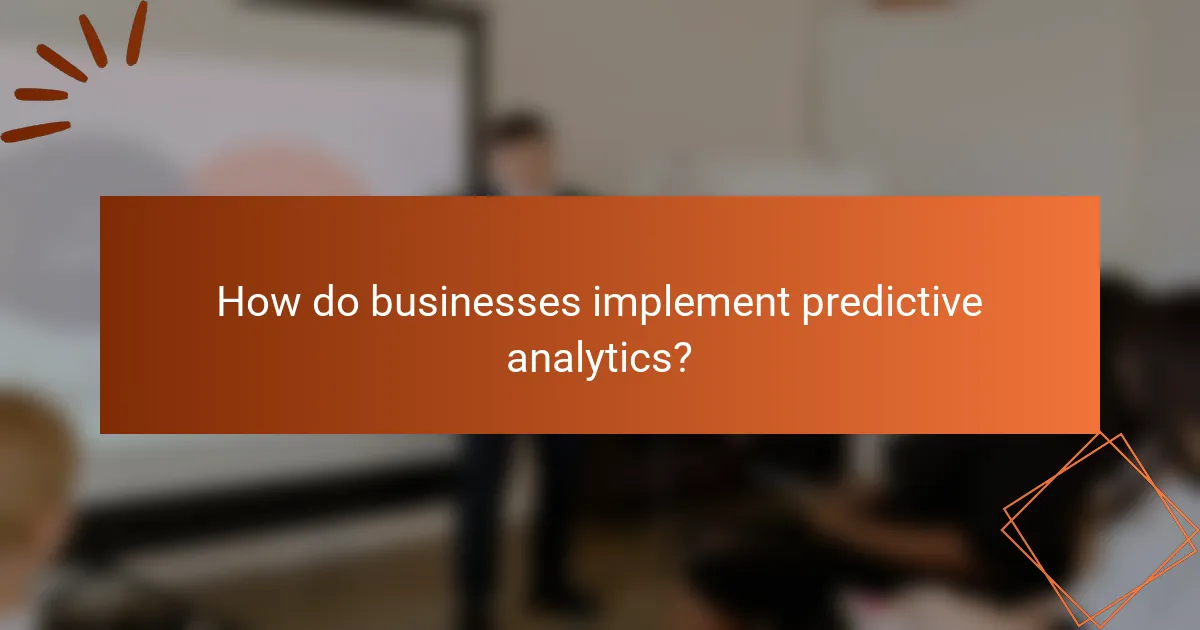
How do businesses implement predictive analytics?
Businesses implement predictive analytics by following a structured approach that includes data collection, model selection, and integration with existing systems. This process enables organizations to make informed decisions based on data-driven insights.
Data collection and preparation
The first step in implementing predictive analytics is gathering relevant data from various sources, such as customer interactions, sales records, and market trends. This data must then be cleaned and organized to ensure accuracy and consistency.
Common data preparation tasks include removing duplicates, handling missing values, and normalizing data formats. Businesses should also consider the legal implications of data collection, particularly regarding privacy regulations like GDPR in Europe.
Model selection and training
After preparing the data, businesses need to select appropriate predictive models based on their specific objectives. Common models include regression analysis, decision trees, and neural networks, each with its strengths and weaknesses.
Once a model is chosen, it must be trained using historical data to identify patterns and relationships. This training process often involves splitting the data into training and testing sets to evaluate the model’s accuracy and effectiveness.
Integration with existing systems
The final step is integrating the predictive analytics model with existing business systems, such as CRM or ERP platforms. This integration allows organizations to leverage insights in real-time decision-making processes.
Successful integration requires collaboration between IT and business teams to ensure that the predictive analytics tools align with operational workflows. Businesses should also monitor the model’s performance regularly and make adjustments as necessary to maintain accuracy and relevance.
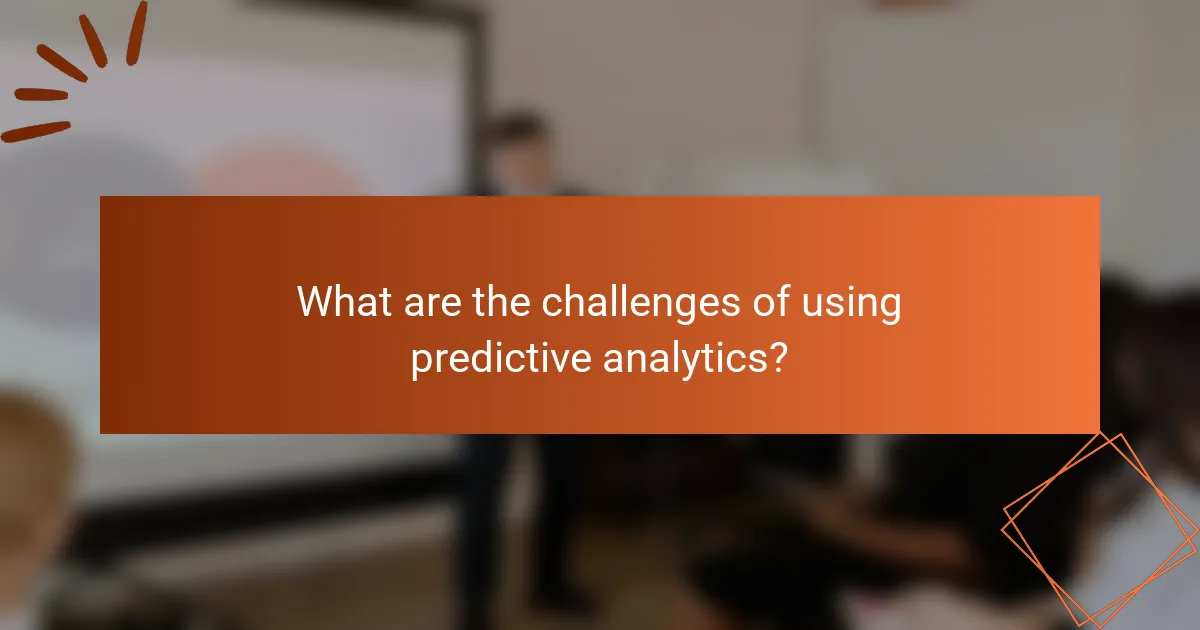
What are the challenges of using predictive analytics?
Using predictive analytics presents several challenges that can hinder its effectiveness. Key issues include data quality, skill gaps among analysts, and privacy concerns, all of which can significantly impact the accuracy and reliability of predictive models.
Data quality issues
Data quality is crucial for effective predictive analytics. Inaccurate, incomplete, or outdated data can lead to misleading predictions and poor decision-making. Organizations should regularly audit their data sources and implement robust data cleaning processes to ensure high-quality inputs.
Common data quality issues include missing values, inconsistent formats, and errors in data entry. Establishing clear data governance policies can help mitigate these problems and enhance the reliability of predictive analytics outcomes.
Skill gaps in analytics
Many organizations face skill gaps in analytics, which can limit their ability to leverage predictive models effectively. A shortage of trained data scientists and analysts can result in underutilization of predictive analytics tools and techniques.
To address this challenge, companies should invest in training programs for existing staff and consider hiring specialists with expertise in data analysis and machine learning. Collaborating with educational institutions can also help bridge the skills gap in the workforce.
Privacy and ethical concerns
Privacy and ethical concerns are significant challenges in predictive analytics, particularly when handling sensitive data. Organizations must comply with regulations such as GDPR in Europe or CCPA in California, which govern data usage and protect consumer rights.
To navigate these concerns, businesses should adopt transparent data practices and ensure that their predictive models are designed with ethical considerations in mind. Implementing strong data protection measures and obtaining informed consent from users can help build trust and mitigate risks associated with privacy violations.
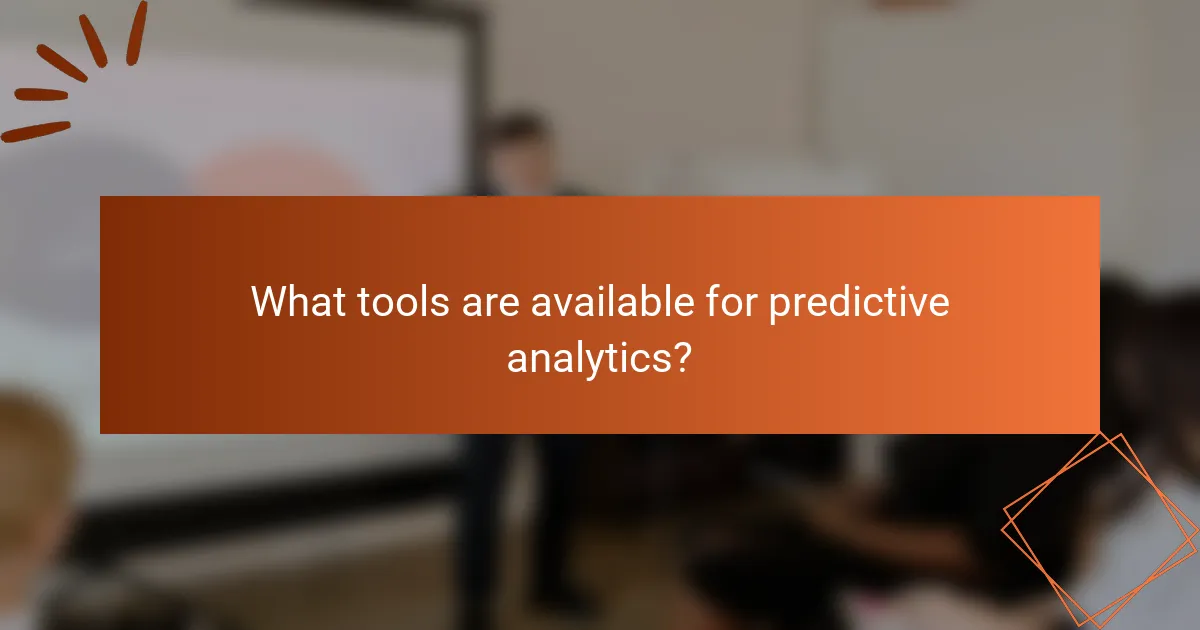
What tools are available for predictive analytics?
Several tools are available for predictive analytics, each offering unique features and capabilities. These tools help organizations analyze data patterns and forecast future trends, enhancing decision-making processes.
IBM Watson Analytics
IBM Watson Analytics is a cloud-based tool that leverages artificial intelligence to simplify data analysis. It provides users with natural language processing capabilities, allowing them to ask questions in plain language and receive insights quickly.
Key features include automated data visualization, predictive modeling, and easy integration with various data sources. Organizations can use it to identify trends, uncover hidden patterns, and make data-driven decisions efficiently.
Google Cloud AI
Google Cloud AI offers a suite of machine learning tools that facilitate predictive analytics through scalable infrastructure. It enables users to build and deploy machine learning models using pre-trained algorithms or custom models tailored to specific needs.
This platform supports various data types and provides robust tools for data preparation, model training, and evaluation. Businesses can utilize Google Cloud AI to enhance customer experiences, optimize operations, and drive strategic initiatives based on predictive insights.
